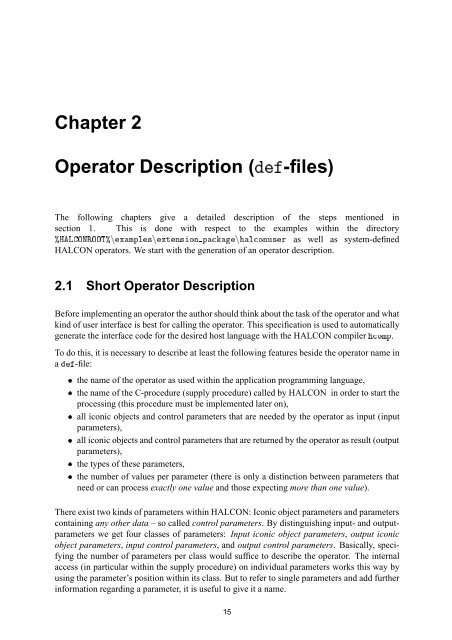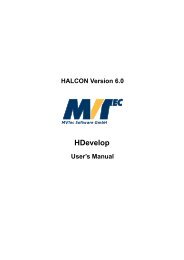HALCON Extension Package Programmer's Manual
HALCON Extension Package Programmer's Manual
HALCON Extension Package Programmer's Manual
- No tags were found...
Create successful ePaper yourself
Turn your PDF publications into a flip-book with our unique Google optimized e-Paper software.
Chapter 2Operator Description (-files)The following chapters give a detailed description of the steps mentioned insection 1. This is done with respect to the examples within the directory±ÀÄÇÆÊÇÇ̱ÒÜÑÔÐ×ÒÜØÒ×ÓÒ ÔÒÐÓÒÙ×Ö as well as system-defined<strong>HALCON</strong> operators. We start with the generation of an operator description.2.1 Short Operator DescriptionBefore implementing an operator the author should think about the task of the operator and whatkind of user interface is best for calling the operator. This specification is used to automaticallygenerate the interface code for the desired host language with the <strong>HALCON</strong> compiler ÓÑÔ.To do this, it is necessary to describe at least the following features beside the operator name ina -file:¯ the name of the operator as used within the application programming language,¯ the name of the C-procedure (supply procedure) called by <strong>HALCON</strong> in order to start theprocessing (this procedure must be implemented later on),¯ all iconic objects and control parameters that are needed by the operator as input (inputparameters),¯ all iconic objects and control parameters that are returned by the operator as result (outputparameters),¯ the types of these parameters,¯ the number of values per parameter (there is only a distinction between parameters thatneed or can process exactly one value and those expecting more than one value).There exist two kinds of parameters within <strong>HALCON</strong>: Iconic object parameters and parameterscontaining any other data –socalledcontrol parameters. By distinguishing input- and outputparameterswe get four classes of parameters: Input iconic object parameters, output iconicobject parameters, input control parameters, andoutput control parameters. Basically, specifyingthe number of parameters per class would suffice to describe the operator. The internalaccess (in particular within the supply procedure) on individual parameters works this way byusing the parameter’s position within its class. But to refer to single parameters and add furtherinformation regarding a parameter, it is useful to give it a name.15
















